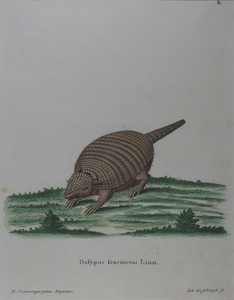| Method | Copper engraving with hand colouring |
| Artist | Johann Nussbiegel after Heinrich Altenwanger |
| Published | Wolfgang Walther, Erlangen, Germany, c.1775. |
| Dimensions | Image and plate 230 x 180 mm |
| Notes |
Plate from 'Die Saugthiere in Abbildungen nach der Natur mit Beschreibungen' 'Animal Illustrations after Nature', or 'Schreber's "Fantastic Animals"' by Johann Christian Daniel von Schreber. Johann Christian Daniel von Schreber (1739-1810) was a German physician and naturalist. He studied botany with the famous Swedish taxonomist, Carl Linnaeus. From then on, his interest in medicine & botany ran parallel courses, with both an appointment as professor of medicine at University of Erlangen & an appointment as the director of the Erlanger Botanical Gardens & Natural History Museum. Schreber was knighted in 1791. In 1774, he began what was to be his masterpiece, a work on the mammals of the world, using the taxonomic system of Linnaeus 'Die Saugthiere in Abbildungen nach der Natur mit Beschreibungen' 'Animal Illustrations after Nature', or 'Schreber's Fantastic Animals' published by Wolfgang Walther, Erlangen: 1775-1792. It was illustrated, containing 755 coloured prints of mammals of the world. For the most the artists, who included such luminaries of the day as George Edwards & De Seve, worked from descriptions of the animals by others who had seen them, rather than actual specimens. The resulting images were sometimes more than a little inaccurate, hence the title of Schreber's "Fantastic Beasts", this charming naiveté making these rare prints highly prized by collectors. Johann Nussbiegel (1750 in Nuremberg - c.1829) was a German draftsman and engraver in Nuremberg. He was the son and student of the Nuremberg engraver and publisher Georg Paul Nussbiegel (1713-1776). Nussbiegel was a member of the Nuremberg Painters Academy. |
| Framing | mounted |
| Price | £65.00 |
| Stock ID | 46488 |

